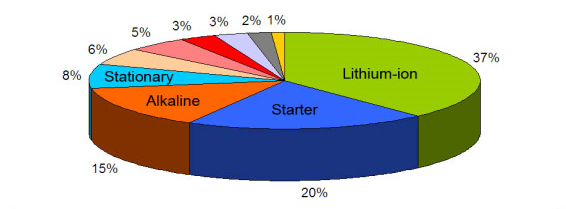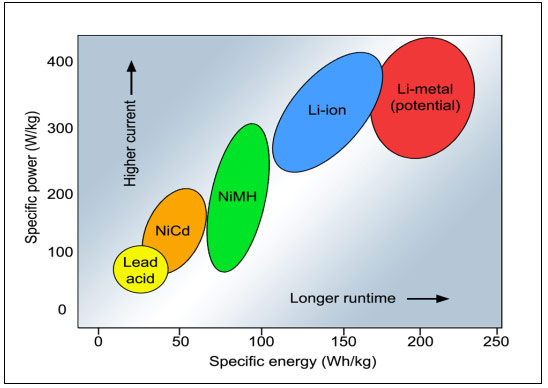Global Battery Markets
Learn about different battery systems, explore future trends and discover which chemistries are most promising.
According to The Freedonia Group, a Cleveland-based industry research firm, the world demand for primary and secondary batteries is forecasted to grow by 7.7 percent annually, amounting to US$120 billion in 2019. The real growth lies in secondary (rechargeable) batteries and according to Frost & Sullivan, secondary batteries account for 76.4 percent of the global market, a number that is expected to increase to 82.6 percent in 2015. The demand is driven by mobile phones and tablets. Earlier estimations over-estimated the demand for electric vehicles and the figures have since been adjusted downwards.
In 2009, primary batteries made up 23.6 percent of the global market and Frost & Sullivan predicted a 7.4 percent decline by 2015. Non-rechargeable batteries are used in watches, electronic keys, remote controls, toys, flashlights, beacons, and military devices in combat.
An Overview of Battery Types
Batteries are
classified by chemistry, and the most common are lithium-, lead-, and nickel-based systems. Figure 1 illustrates the
distribution of these chemistries. At a 37 percent revenue share, Li-ion is the
battery of choice for portable devices and
the electric powertrain. There are
no other systems that threaten its
dominance today.

|
Figure 1: Revenue contributions by
different battery chemistries |
Lead acid stands its ground as being a robust and economical power source for bulk use. Even though Li-ion is making inroads into the lead acid market, the demand for lead acid batteries is still growing. The applications are divided into starter batteries for automotive, also known as SLI (20%), stationary batteries for power backup (8%), and deep-cycle batteries for wheeled mobility (5%) such as golf cars, wheelchairs and scissor lifts.
New markets that further boost battery growth are the electric bicycle and
storage systems for renewable energy, from which homeowners, businesses and
developing nations are benefiting. Large grid storage batteries collect surplus energy during
high activity and bridge the gap when the input is low or when user demand is
heavy.
Advancements in Batteries
Batteries are advancing on two fronts, reflecting in increased specific energy for longer runtimes and improved specific power for high-current load requirements. Improving one characteristic of a battery may not automatically strengthen the other and there is often a compromise. Figure 2 illustrates the relationship between specific energy in Wh/kg and specific power in W/kg.
Specific energy is the capacity a battery
can hold in watt-hours per kilogram (Wh/kg); specific power is the battery’s ability
to deliver power in watts per kilogram (W/kg).
Figure 2: Specific energy and specific power of rechargeable batteries
The best performing battery in terms of specific energy and specific power is
the secondary lithium-metal (Li-metal). An early version was introduced in the
1980s by then Moli Energy, but instability with metallic lithium on the anode
prompted a recall in 1991. 
The best performing battery in terms of specific energy and specific power is the secondary lithium-metal (Li-metal). An early version was introduced in the 1980s by then Moli Energy, but instability with metallic lithium on the anode prompted a recall in 1991.
With 15 year’s of battery engineering and design experience, Fello Tech provides customers with effective and efficient battery solutions. Fello Tech has a proven reputation with a broad customer base for the supply of high safety batteries, battery packs and customized batteries. Our dedicated inhouse team will design, build and supply you the most advanced range of the batteries supported with the reassurance of first class quality standards.
You can contact us any way that is convenient for you. We are available 24/7 via !
If you need any lithium battery or battery packs, please send us your detailed information about the voltage, the capacity and the size.
 online service
online service 86 755 89351622
86 755 89351622 sales@fellotech.com
sales@fellotech.com lucyjiang123
lucyjiang123 +8613691821586
+8613691821586